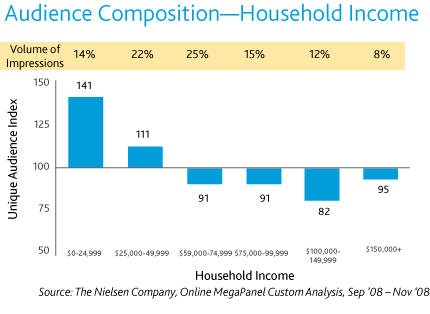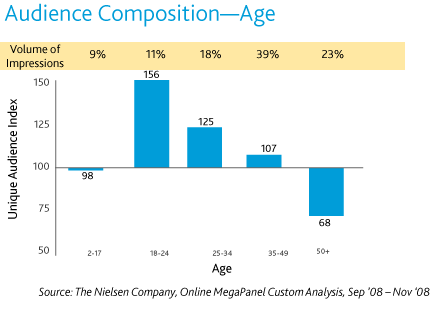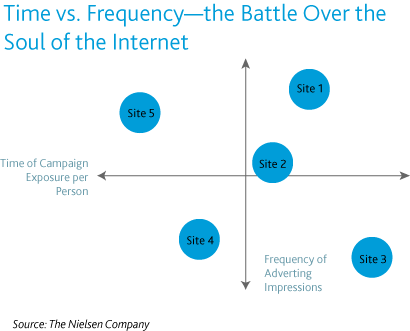
Jon Gibs, Vice President, Media Analytics, The Nielsen Company
SUMMARY: Why do advertisers still debate the value of online advertising? Because no precise measure of online audience delivery exists. The missing factor? Who—as in who is viewing your ads, not just how many ads were served. Does online advertising deliver the target audience? With current evaluation methods, it’s difficult to tell. What’s needed is a shift in metrics for audience targeting from impressions to dwell time, increasing the cost per thousand in the process.
Because of their simplicity, we in media research tend to overlook the core principles of successful advertising. These principles can be reduced to three basic questions:
- How many?
- Who?
- Did it work?
“How many?” is the volume of ads, using measures like impressions, gross rating points and the like. “Who?” is the targeted audience, whatever parameters are selected to define the desired population like age, income, education and household size. “Did it work?” is the effectiveness of the campaign. Did it change the thinking or behavior of viewers? Did it increase brand awareness? Did it drive purchase? The online advertising industry is very good at measuring “how many?” in the form of ad serving reports. We have also developed multiple models around “did it work?”, from branding studies to offline sales impact. We, however, have spent little time on the second question, “who?” The irony is that this question—the demographics of those people exposed to the ad campaign—is at the core of ad delivery reporting in almost all other media.
The missing link
Measures of demographic delivery are critical for every other form of media buying. The Internet, however, skipped over this link in the media value chain. Online publishers have spent a decade trying to answer the question “Does online advertising work?” The problem is, that’s the wrong question. This question has driven advertisers to focus on direct response metrics, such as click through, or short term brand lift, without any consideration of the long-term branding impacts on the advertisers’ targets.
The right question is “who does the advertising reach?” This is the question asked of almost all other media, where there is an understanding that a great deal of the impact of the advertising is related to the creative, rather than the media placement. To get to the answer of “who”, the industry needs to develop a standardized, robust, post-buy reporting structure to help keep the targeters on target, and prove from end-to-end, the value of Internet advertising.
Targeting for today
Targeting in the Internet world refers to any form of online advertising that is not run-of-site, run- of-network or content section-specific. I would argue that even contextual, content section specific ads are targeted. One of the great advantages of online advertising is that, unlike traditional media, targeting happens on the execution side, not just in planning. For online or mobile media, the first step in a campaign mirrors traditional media. Marketers determine a schedule of web sites, portals or ad networks that will deliver the desired audience.
The big difference: online media buyers can also buy actual audience segments based on elements like geo-coded inventory through a reverse IP look-up, modeled segmentation based on cookie or panel data, offline sales data, registered user data and a host of other possibilities. As this form of targeting grows in popularity, conventional census-based delivery reports become less useful as many only show raw server counts of impressions—rather than highlighting the ability of publishers to deliver on their promised targets.
Says who?
Another issue with actual online results is that they tend toward unreliable self-reporting. While reports cover impressions, they tend to skirt the issue of targeting accuracy. Some chalk it up to the fact that audience delivery metrics aren’t sexy, while a more cynical group asserts that it has more to do with not wanting agencies or publishers to look bad if results fall short.
Yet another opinion points to the fact that measurement firms have only recently started to produce post-buy reports. Since each research company uses a slightly different methodology, it is impossible to compare results across campaigns and vendors. Also, in many cases, these reports can’t be generated for some forms of behavioral targeting without the client revealing proprietary information.
Prime examples
Examples of online measurement at work for a mobile phone manufacturer include one case using household income as a segmentation criterion, the other using age as a criterion. In the first scenario, the company wanted to market a low-cost smart phone to middle income households in the $50,000–$75,000 per-year range.

According to a Nielsen analysis, the campaign failed badly. Only about 25% of advertising reached the targeted households. Even more disheartening, the supposedly targeted campaign impacted 9% fewer target audience members than a more general run-of-network buy. Three out of four ad dollars were wasted on other segments.
Killer app
In a second example, the mobile phone manufacturer was rolling out its new killer app—an iPhone substitute designed for young adults ages 18–24 primarily, and 25–34 secondarily. Results were better in this case, albeit mixed.

The good news: the campaign over-indexed significantly among the two targeted age groups, 56% more for the primary audience and 25% more for the secondary audience than a random campaign would deliver. The bad news: 62% of impressions accrued to consumers age 35+, outside of the preferred demographic. Although disappointing, it makes sense given the age distribution of the U.S. and online populations which skew older.
Timing is everything
Although ad impression counts traditionally have been the currency of the Internet, there is reason to believe that this accounting method itself had led to the decline of online advertising CPMs. Since publishers are paid on the number of ads served, many have created cluttered environments that increase inventory levels beyond demand—therefore driving down CPMs.
This decline in CPMs is made up by serving more ads and therefore, continuing to decrease the value of any individual ad unit. This cycle creates a financial situation where publishers are disincentivized in the short-term to provide a good advertising environment because they need to create more clutter. This clutter does not simply decreases CPMs, but also advertising effectiveness and therefore, the value of the media overall to advertisers.
In essence, because the Internet is the first medium with truly unlimited inventory potential (i.e., one can cut pages into tiny bits and there is no significant cost of delivery), an impression-based ad model has driven publishers to look for short-term gains at the expense of the long-term health of the industry.
So, what is the answer? When it comes to online advertising, time is the x-factor. Most research suggests that the longer a person is exposed to an ad, the more effective it will be—up to the point of diminishing returns. Perhaps the future of post-buy reporting—and online advertising—has more to do with time than impressions or page views.
The reason for this is that time is the only equalizing measure between the three core groups of online content—video, social media and standard content. Rather than simply counting the number of impressions served, the appropriate measure becomes the “dwell time” (time spent) on a page or with an impression. Using this method, we are also able to reduce inventory (and perhaps drive up CPMs) by saying that impressions that only have a “dwell time” above certain levels are actually counted as true impressions.
Time vs. frequency
A time-based post-buy measure rewards sites that surround advertising with a robust contextual environment, encouraging audience “dwelling.” As the graph illustrates, Site 3 provides a big bang for the buck on a per-target basis, generating fewer but much longer impressions, effectively increasing the value of each impression to the advertiser.

Conversely, Site 4 pursues an outdated approach of ramping up the number of impressions with much shorter exposure times, decreasing the value of each impression. As the value of each impression goes up, so should the CPM.
The way forward
If the Internet is to improve CPMs—and perhaps save the overall advertising market from its fate—we must focus on time-based post reporting. The post reporting itself provides brand advertisers with what they really need and understanding if their ads reach the audience they seek. The time element rewards those sites that limit their inventory by adding a financial incentive to create a good environment for advertising and also links inventory measures to a counting method that should produce more effective advertising overall.
Now that’s something to dwell on.


